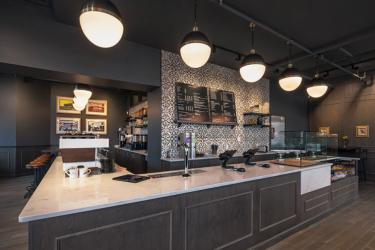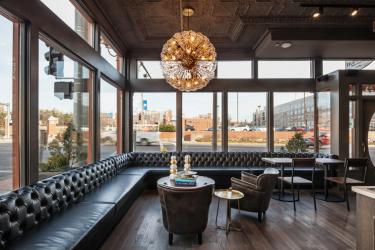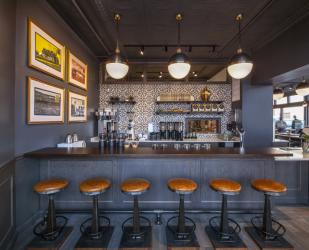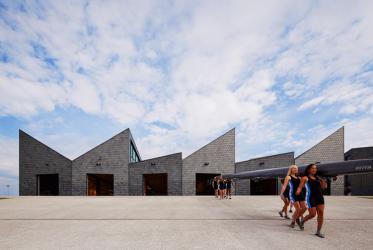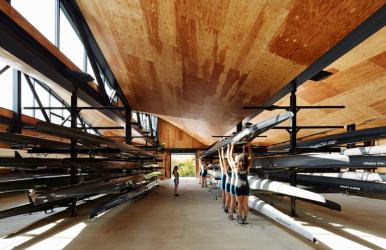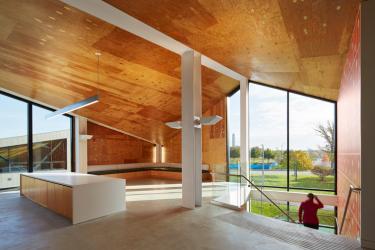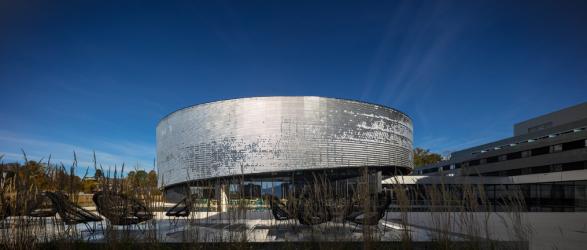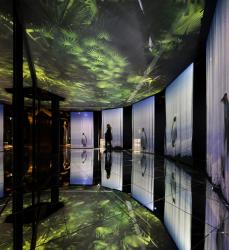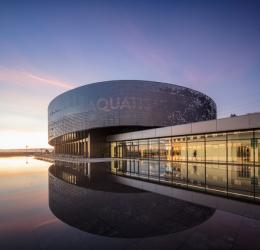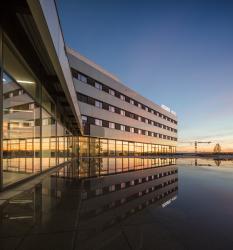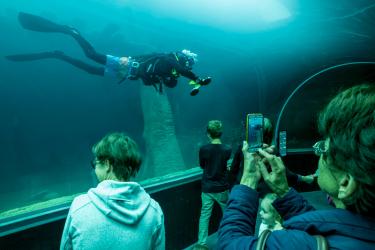Kaldi’s Coffee in the Gerhart Building, St. Louis, MO
Photography by Matt Marcinkowski
The Gerhart building, constructed in 1897, was nominated for the National Register of Historic Places because of its eclectic French Renaissance style, called Chateauesque. Because of this design, SPACE Architecture + Design had to incorporate not only the Kaldi's coffee brand into the new cafe, but also honor the building’s historic and memorable style. SPACE designed several unique elements specifically for this location. To highlight Vandeventer Avenue, SPACE crafted a bar at the window facing the street. They also added a banquette, which wraps around the corner of the interior. While these additions complement the building’s original design, white oak veneer panelling lines the walls with a stain to match Kaldi’s signature gray color. Despite the dark interior, light spills in through large windows for most of the day, and at night, bright fixtures add plenty light to work beneath. These elements were all chosen by SPACE Architecture + Design in partnership with the owner to reflect the store’s character, and provide an atmosphere of high-end design to match the building’s historic build.
WMS Boathouse at Clark Park, Chicago IL
Photography by Steve Hall, Hedrich Blessing
The Chicago Park District is working on transforming the previously polluted and neglected Chicago River. One of the first steps in bringing life back to this stretch of water was adding the WMS Boathouse at Clark Park, completed in 2013 by Studio Gang Architects. The Boathouse not only works to bring a recreational feel to the riverfront, but also to revive the location ecologically. To do this, the design team focused largely on one of the largest obstacles in improving the river’s water quality; stormwater flooding the city’s sewer system. The new filtration system consists of porous concrete and asphalt, native Chicago plants, gravel beds and rain gardens to both maintain and strengthen surrounding habitats. Alternating inverted V and M shaped trusses on the roof of the building not only mimic the motion and rhythm of rowing, they also let in light through the clerestory. This light warms the floor below in the winter and ventilates the space in the summer to minimize energy use across the board. The revitalization of the natural riverfront with the addition of this the Boathouse at Clark Park hopes to draw in a younger audience.
Aquatis, Lausanne Switzerland
Photography by © Fernando Guerra | FG+SG | architectural photography
The Biopole, a science-based park in the northern section of Lausanne, Switzerland, just added a hub at the crossroads of its new M2 line of the metro. Aquatis offers travelers a place to stay and learn before their next train leaves. Connected to the metro station by a central mall, Aquatis is more than the hotel it offers; its second floor is dedicated entirely to the two million liters of fresh water, 20 different ecosystems, 10,000 species of fish and 100+ reptiles of the Aquatis aquarium. Designed by Ritcher Dahl Rocha & Associes Architectes and finished in 2010, the three levels of the facility nestles comfortably in the area’s uneven terrain while offering a beautiful view of South Lausanne. The Aquarium is the centerpiece to this architectural feat. Its circular shape reflects its educational and cultural mission, and 100,000 aluminum discs glitter independently in the wind thanks to their fastening system. Because the wind moves each separately, the effect usually translates as rippling fish scales or waves on water. With its obviously natural focus, Aquatis is also dedicated to sustainable development through using renewable resources and lowering greenhouse gas emissions.


